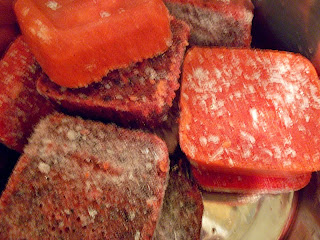 |
| Strawberry in Triplicate |
Preserving Strawberry Fruits
Strawberries appear once again in the corners of the garden and bargain pricing in supermarkets. The warmer seasons produce a wealth of berries. Preserving these sweet, delicate fruits is a simple process whether in jams, jellies, freezer bags, or dehydrated form.
Canning Strawberry Jam
The strawberry is one of the fruits most people use to start canning projects. These preserves help develop a sense of the process and its requirements. The steps are fairly straightforward. Sterilize equipment, prepare fruit and jars properly, and use the right ingredients. The skills learned from making strawberry jam will migrate into other canning projects. The base instructions are the same.
Best results require that quality fruits be used in these projects. Firm, sweet berries result in a top quality product.
Gather all ingredients needed before starting up the processing. Add water to the water bath canner and set the heat on medium so that the water is at the right temperature when the jam mixture is finally ready to go in the jars. When all items are set in place, the ingredients measured and ready, the equipment is gathered and clean, the act of canning jam is a fun and simple project.
If the jam does not set for one reason or another, use it as a syrup. The firmer jams tend to tear bread, but the thinner confection spreads easily and tastes just as good! Use it on pancakes or french toast, in smoothies and shakes, slushes, or as flavoring in baked goods.
Basic Strawberry Jam Recipe
5 cups mashed berries
7 cups sugar
1 box pectin
1/4 c lemon juice
1 T butter
Instructions in video:
The video below was produced several years ago by this author. It will be refilmed eventually... Enjoy!
Strawberry Jam Instruction Video
Freezing Strawberries
 |
| The colorful ice blocks are blended berry mixes. |
Whole berries should be washed, stemmed, and checked for blemishes. Use a small spoon to remove the stem piece. This will help conserve fruit material. Let washed berries dry for a short time to eliminate excess moisture. Place on a rack or blot dry on a towel. The dryer the berry, the better it will freeze. Water droplets attract frost in the freezer compartment and cause freezer burn. Berries keep for up to a year frozen.
Strawberries are often frozen whole or sliced in form, but running them through a blender can also be a great freezing method. The ice blocks pictured were frozen in plastics and placed into ziplocks when solid. These organize easier than the whole berry bags do. One might consider adding a bit of fruit preserver or a bit of lemon juice. One teaspoon per cup should work fine, but it is not needed. These blocks may be melted down later and used in jams, slushes, and smoothies or additional creative food dishes. These may also be eaten as is...
Dehydrating Strawberries
Wash berries and remove stems as suggested in the freezing section above. A standard dehydrator will take three 3 to four hours to dry fruit. Slice fruits in quarters and place on dehydrator rack. An oven set on 200 degrees may also be used. Place fruit on baking sheet and check occasionally for progress. Let cool when ready and keep in cool, dark place. Freeze if desired to preserve fruit long term. The dried berries may be used in cereals, eaten as is or rehydrated later for baking.
For more food storage tips visit:
Survival Recovery
Now that we have jam it is time to bake some great bread!
All rights reserved 2015
No comments:
Post a Comment